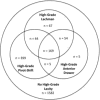Effect of High-Grade Preoperative Knee Laxity on Anterior Cruciate Ligament Reconstruction Outcomes
- PMID: 27480978
- PMCID: PMC5770143
- DOI: 10.1177/0363546516656835
Effect of High-Grade Preoperative Knee Laxity on Anterior Cruciate Ligament Reconstruction Outcomes
Abstract
Background: Knee laxity in the setting of suspected anterior cruciate ligament (ACL) injury is frequently assessed through physical examination using the Lachman, pivot-shift, and anterior drawer tests. The degree of laxity noted on these examinations may influence treatment decisions and prognosis.
Hypothesis: Increased preoperative knee laxity would be associated with increased risk of subsequent revision ACL reconstruction and worse patient-reported outcomes 2 years postoperatively.
Study design: Cohort study; Level of evidence, 2.
Methods: From an ongoing prospective cohort study, 2333 patients who underwent primary isolated ACL reconstruction without collateral or posterior cruciate ligament injury were identified. Patients reported by the operating surgeons as having an International Knee Documentation Committee (IKDC) grade D for Lachman, anterior drawer, or pivot-shift examination were classified as having high-grade laxity. Multiple logistic regression modeling was used to evaluate whether having high-grade preoperative laxity was associated with increased odds of undergoing revision ACL reconstruction within 2 years of the index procedure, controlling for patient age, sex, Marx activity level, level of competition, and graft type. Multiple linear regression modeling was used to evaluate whether having high-grade preoperative laxity was associated with worse IKDC score or Knee injury and Osteoarthritis Outcome Score Knee-Related Quality of Life subscale (KOOS-QOL) scores at a minimum 2 years postoperatively, controlling for baseline score, patient age, ethnicity, sex, body mass index, marital status, smoking status, sport participation, competition level, Marx activity rating score, graft type, and articular cartilage and meniscus status.
Results: Pre-reconstruction laxity data were available for 2325 patients (99.7%). Two-year revision data were available for 2259 patients (96.8%), and patient-reported outcomes were available for 1979 patients (84.8%). High-grade preoperative laxity was noted in 743 patients (31.9%). The mean postoperative IKDC score was 81.8 ± 15.9, and the mean KOOS-QOL score was 72.0 ± 22.0. The presence of high-grade pre-reconstruction laxity was associated with significantly increased odds of ACL graft revision (odds ratio [OR] = 1.87 [95% CI, 1.19-2.95]; P = .007). The presence of high-grade pre-reconstruction laxity was not associated with any difference in postoperative IKDC (β = -0.56, P = .44) or KOOS-QOL (β = 0.04, P = .97).
Conclusion: The presence of high-grade pre-reconstruction knee laxity as assessed by manual physical examination under anesthesia is associated with significantly increased odds of revision ACL surgery but has no association with patient-reported outcome scores at 2 years after ACL reconstruction.
Keywords: anterior cruciate ligament; diagnosis; knee laxity; knee ligaments.
© 2016 The Author(s).
Figures
Similar articles
-
Effect of High-Grade Preoperative Knee Laxity on 6-Year Anterior Cruciate Ligament Reconstruction Outcomes.Am J Sports Med. 2018 Oct;46(12):2865-2872. doi: 10.1177/0363546518793881. Epub 2018 Sep 7. Am J Sports Med. 2018. PMID: 30193087 Free PMC article.
-
Ten-Year Outcomes and Risk Factors After Anterior Cruciate Ligament Reconstruction: A MOON Longitudinal Prospective Cohort Study.Am J Sports Med. 2018 Mar;46(4):815-825. doi: 10.1177/0363546517749850. Am J Sports Med. 2018. PMID: 29543512 Free PMC article.
-
Anterior and Rotational Knee Laxity Does Not Affect Patient-Reported Knee Function 2 Years After Anterior Cruciate Ligament Reconstruction.Am J Sports Med. 2019 Jul;47(9):2077-2085. doi: 10.1177/0363546519857076. Am J Sports Med. 2019. PMID: 31307221 Free PMC article.
-
Multiple revision anterior cruciate ligament reconstruction: not the best but still good.Knee Surg Sports Traumatol Arthrosc. 2023 Feb;31(2):559-571. doi: 10.1007/s00167-022-07197-8. Epub 2022 Oct 12. Knee Surg Sports Traumatol Arthrosc. 2023. PMID: 36224291 Free PMC article.
-
Good mid-term outcomes and low rates of residual rotatory laxity, complications and failures after revision anterior cruciate ligament reconstruction (ACL) and lateral extra-articular tenodesis (LET).Knee Surg Sports Traumatol Arthrosc. 2020 Feb;28(2):418-431. doi: 10.1007/s00167-019-05625-w. Epub 2019 Jul 19. Knee Surg Sports Traumatol Arthrosc. 2020. PMID: 31324964
Cited by
-
Anterior Cruciate Ligament Reconstruction in High School and College-Aged Athletes: Does Autograft Choice Influence Anterior Cruciate Ligament Revision Rates?Am J Sports Med. 2020 Feb;48(2):298-309. doi: 10.1177/0363546519892991. Epub 2020 Jan 9. Am J Sports Med. 2020. PMID: 31917613 Free PMC article.
-
Lower medial hamstring activity after ACL reconstruction during running: a cross-sectional study.BMJ Open Sport Exerc Med. 2021 Mar 11;7(1):e000875. doi: 10.1136/bmjsem-2020-000875. eCollection 2021. BMJ Open Sport Exerc Med. 2021. PMID: 33782638 Free PMC article.
-
[Development of on-line lateral stiffness measurement system for anterior cruciate ligament and its influence on anterior cruciate ligament reconstruction].Sheng Wu Yi Xue Gong Cheng Xue Za Zhi. 2021 Feb 25;38(1):145-153. doi: 10.7507/1001-5515.202006060. Sheng Wu Yi Xue Gong Cheng Xue Za Zhi. 2021. PMID: 33899439 Free PMC article. Chinese.
-
Effect of High-Grade Preoperative Knee Laxity on 6-Year Anterior Cruciate Ligament Reconstruction Outcomes.Am J Sports Med. 2018 Oct;46(12):2865-2872. doi: 10.1177/0363546518793881. Epub 2018 Sep 7. Am J Sports Med. 2018. PMID: 30193087 Free PMC article.
-
Risk factors for ACL revision failure and optimum graft size for revision anterior cruciate ligament reconstruction.Eur J Orthop Surg Traumatol. 2025 Jun 19;35(1):260. doi: 10.1007/s00590-025-04381-7. Eur J Orthop Surg Traumatol. 2025. PMID: 40536685 Free PMC article.
References
-
- Andernord D, Desai N, Bjornsson H, Ylander M, Karlsson J, Samuelsson K. Patient predictors of early revision surgery after anterior cruciate ligament reconstruction: a cohort study of 16,930 patients with 2-year follow-up. Am J Sports Med. 2015 Jan;43(1):121–127. - PubMed
-
- Donaldson WF, 3rd, Warren RF, Wickiewicz T. A comparison of acute anterior cruciate ligament examinations. Initial versus examination under anesthesia. Am J Sports Med. 1985 Jan-Feb;13(1):5–10. - PubMed
-
- Dunn WR, Wolf BR, Harrell FE, Jr, Reinke EK, Huston LJ, Spindler KP. Baseline predictors of health-related quality of life after anterior cruciate ligament reconstruction: a longitudinal analysis of a multicenter cohort at two and six years. J Bone Joint Surg Am. 2015 Apr 1;97(7):551–557. - PMC - PubMed
MeSH terms
Grants and funding
LinkOut - more resources
Full Text Sources
Other Literature Sources
Medical



